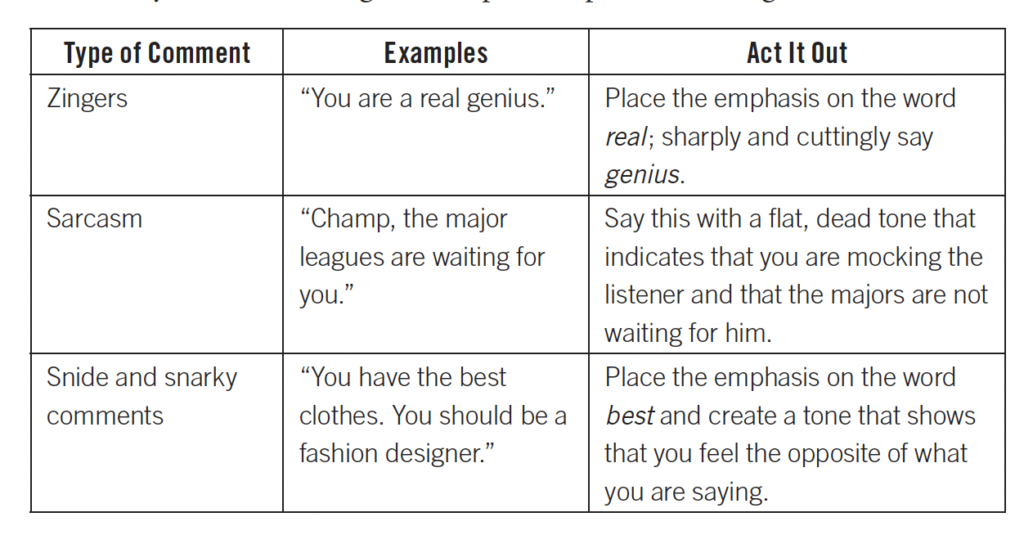Why Your Sarcastic Tone Is Such a Turn Off to Friends, Family & Co-workers

Words matter, yet sometimes how you say something is heard more loudly than what you said. Your tone greatly impacts how your words are perceived. As we know from experience, kind and gentle tones are welcoming while snarky or sarcastic tones rarely go over well. This holds true whether you are in a difficult parenting dynamic, dealing with a spouse or partner, explaining your point of view to friends, collaborating at work or simply trying to better understand another person’s view in a casual conversation.
“Tone,” as defined by Dictionary.com is ‘pitch, volume.’ It can distinguish ‘attitude, spirit, air, approach, expression, inflection, intonation, timbre, quality and style.’
It is crucial that you not only recognize your tone of voice but that you also know how to control it to appropriately convey your message.
Types of Tone
Sarcasm is mainly used to say the opposite of what’s true, and often to make the other person feel off-guard or foolish. Sarcasm is all about the context and tone of voice, which is why it works better verbally. There tends to be a bite or bitterness in the words. You’ll know when you hear it. Be sure to use caution when using it, or you can come across as rude.
Snide often includes mockery, smart aleck.
Sassy is often spirited, outspoken, bold or cheeky.
Note: witty is good, sarcastic is often not. You don’t want to come across as obnoxious, passive-aggressive, offensive, rude or angry.
Exercise: Try to guess what people are saying through verbal and nonverbal communication. For instance, when a person says “yup,” and then “I got it,” in a sharp tone, what is the person trying to tell you with his tone of voice? [Deeper Dive, pgs 123-125 and 185-189 in Why Will No One Play with Me?]

How to Manage Your Tone and Why it Matters
How our words are perceived, and how we communicate verbally and nonverbally with others, represents the majority of all communications. Communication is 7% verbal and 93% non-verbal which includes facial expressions, gestures, postures, and tone.
Tone of voice makes up 38 % of all communication, making it one of the most important factors that influence how we convey our opinion, feelings, and thoughts. It’s easy to be deceptive with your words, but it’s a lot harder to fake a tone of voice. In fact, tone of voice may be an essential element to the success of any relationship. For instance, If you thank someone with a sarcastic tone, it may be perceived as insulting or angry.
How to Ensure What You Mean to Say Comes Across in Your Tone
Step 1: Consider what and how you really want to say how you feel –
It is harder to fake tone than it is to choose our words. Words can be crafted, but tone is hard to fake. Make sure you are in the right head space before you say something complimentary when inside you are feeling angry.
Step 2: Listen to how you sound –
Truly try to hear how you sound to others. Telling someone you are “fine” when you are not, will probably not come across as fine. If you say it with an eye roll or a sarcastic tone, the tone will be heard above the words. How we sound matters just as much, if not more, than what we say.
Step 3: Choose a positive tone of voice –
An occasional sarcastic tone may be OK from time to time, but if used too often, it will come across as rude. In fact, when you use a polite tone of voice, it not only impacts others positively, but you as well.
Step 4: Practice, Practice –
In EVERY conversation, in order to “hit the nail on the head,” we must practice in advance. Pause, breath and set your intention to saying things in a positive tone. This is not natural for most of us; so practice at home, with friends, in the shower, etc.
Sarcastic Tone in Written Correspondence
Don’t allow the veil of the internet to cloud your intent in emails, direct messages, blog post comments, or social media posts. It is common to miss the mark when aiming for a public-appropriate or diplomatic tone. Off-the-cuff comments that include a sarcastic tone can alienate others, inspire retaliation and even ruin a reputation.
Written correspondence should aim toward making colleagues, bosses and decision makers to gravitate “to” you. Aim for composed, articulate and diplomatic dialog at all times.
- Carefully balance emotions with pragmatism – After thoughtfully writing out your response, ask yourself: Does the content add a new viewpoint and educate or does it elicit an emotion, attack or accusation?
- Offer facts – Highlight concrete, objective information to meaningfully support your feelings on a matter.
- Explain your conclusions – Steer away from attacks aimed at proving how clever you are. Instead, the “why’s” and “how’s” that made you arrive at your conclusion. Encourage the reader to understand your point of view as much as possible.
- Be concise yet detailed – No one wants to read lines and lines of text, yet not providing enough content can leave the reader looking for answers and understanding.
- Write from the heart, then edit – Lay out the essence of your emotions first, then slash out negative or harsh tones and inject insight and positive sentiment.
Aim for an end-result that represents you as an engaging and respectable person, one that will educate and attract. Even those who oppose your opinion may still be drawn to you as an emotionally and intellectually-respected person.
Model Positive Behavior
Do you ever find yourself next to someone who you may find boring or strange? We all have at some point. Our instinct may be to turn our shoulder, let our eyes wander or even respond using a sarcastic tone.
Your kids and others are watching. Don’t just talk, walk the walk. Demonstrate the proper way to treat people. Sit with the mom who kind of irritates you and give her a chance. You might be surprised what you learn about – and from – her.
(read more on how to model appropriate behavior)
Your Ability to Communicate is a Critical Life Skill
We’ve been told that we need to stick up for ourselves and ask for what we need. Afterall, communication is required in virtually every relationship, opportunity and experience.
Sarcasm is everywhere and in everyday speech: in literature, on screens, in homes and coffee houses and in backyards. It can tell you a lot about the personality of a character.
Social Skills in Action
More actionable advice, exercises and videos can be found in the Store
Adults with ADHD Social Skills Training: How to Get Along with Everyone – March 2022
Master Class – How to Stop Oversharing as an Adult with ADHD – April 2022
Building social capital is critical for strong relationships. ADHD can get in the way.
How to Coach Your Child – Kids need good role models. Skills like listening and communication are critical. This exclusive program for parents teaches how to coach your kids for life.
Rusty Social Skills Bundle – Everything you need to help students return to the classroom for the development of critical social skills.
Coaching Conversations Video Course – How to use the lessons in Why Will No One Play with Me? in everyday life using real people and real scenarios
From “Hi” to a Full Conversation – How to adapt conversation starters to initiate small talk.
Joining a group Infographic – Make joining a group less intimidating – and more fun!
Building a Conversation Infographic – Learn how to engage in reciprocal give-and-take
Steps for Joining a Group Video – Step by step details to comfortably and successfully join a group
How to Read the Room as an Adult – Managing perceptions and engaging successfully
How to SEL – HOW TO help children build social skills



